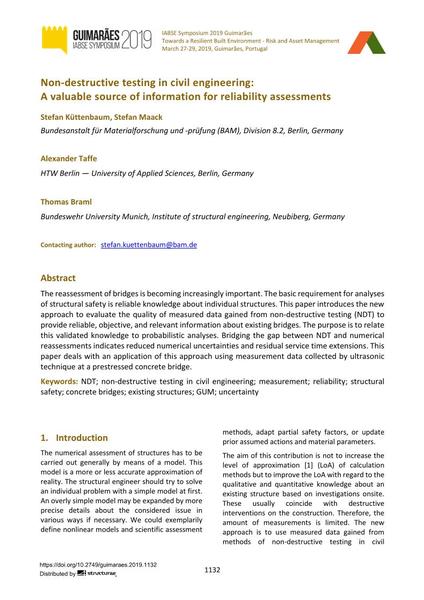Non-destructive testing in civil engineering:

|
|
|||||||||||
Détails bibliographiques
| Auteur(s): |
Stefan Küttenbaum
(Bundesanstalt für Materialforschung und -prüfung (BAM), Division 8.2, Berlin, Germany)
Stefan Maack (Bundesanstalt für Materialforschung und -prüfung (BAM), Division 8.2, Berlin, Germany) Alexander Taffe (HTW Berlin — University of Applied Sciences, Berlin, Germany) Thomas Braml (Bundeswehr University Munich, Institute of structural engineering, Neubiberg, Germany) |
||||
|---|---|---|---|---|---|
| Médium: | papier de conférence | ||||
| Langue(s): | anglais | ||||
| Conférence: | IABSE Symposium: Towards a Resilient Built Environment Risk and Asset Management, Guimarães, Portugal, 27-29 March 2019 | ||||
| Publié dans: | IABSE Symposium Guimarães 2019 | ||||
|
|||||
| Page(s): | 1132-1139 | ||||
| Nombre total de pages (du PDF): | 8 | ||||
| DOI: | 10.2749/guimaraes.2019.1132 | ||||
| Abstrait: |
The reassessment of bridges is becoming increasingly important. The basic requirement for analyses of structural safety is reliable knowledge about individual structures. This paper introduces the new approach to evaluate the quality of measured data gained from non-destructive testing (NDT) to provide reliable, objective, and relevant information about existing bridges. The purpose is to relate this validated knowledge to probabilistic analyses. Bridging the gap between NDT and numerical reassessments indicates reduced numerical uncertainties and residual service time extensions. This paper deals with an application of this approach using measurement data collected by ultrasonic technique at a prestressed concrete bridge. |
||||
| Mots-clé: |
Pont en béton structures existantes
|
||||
